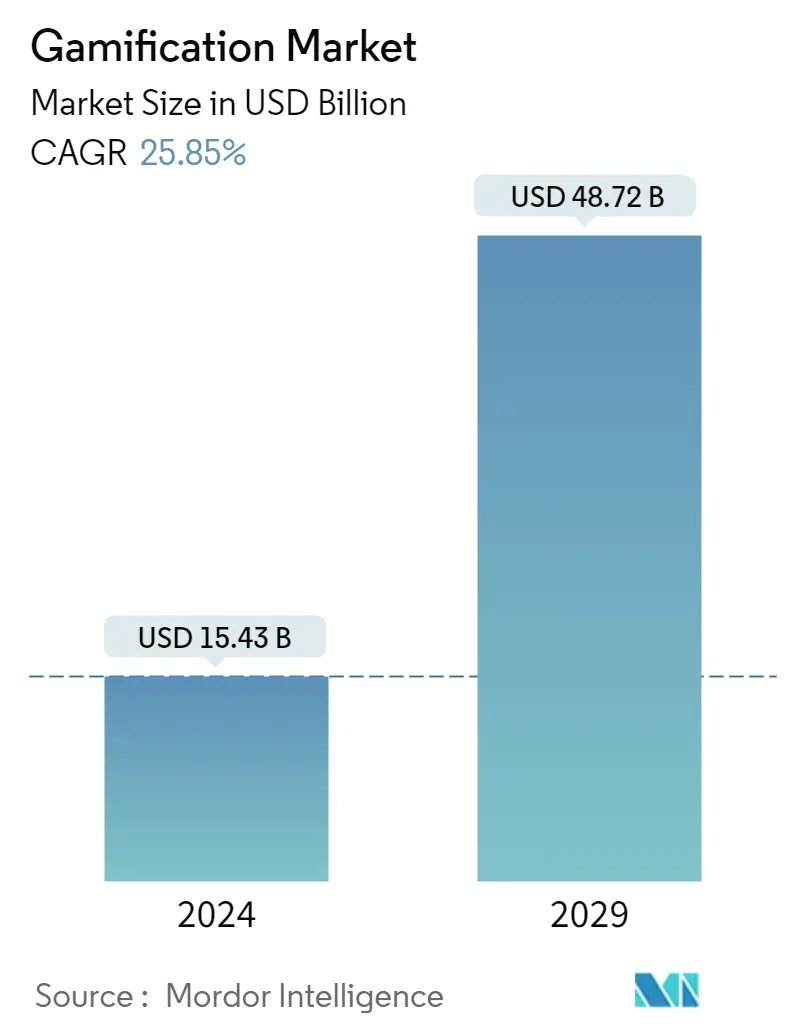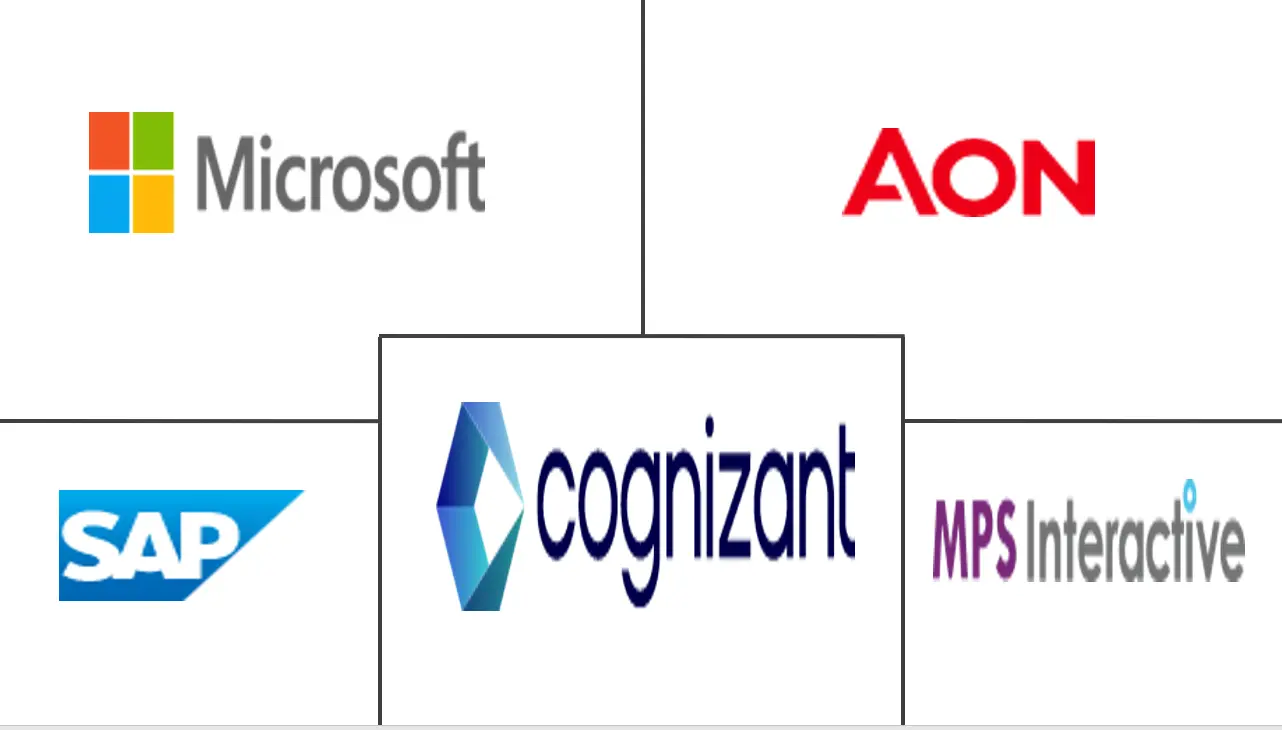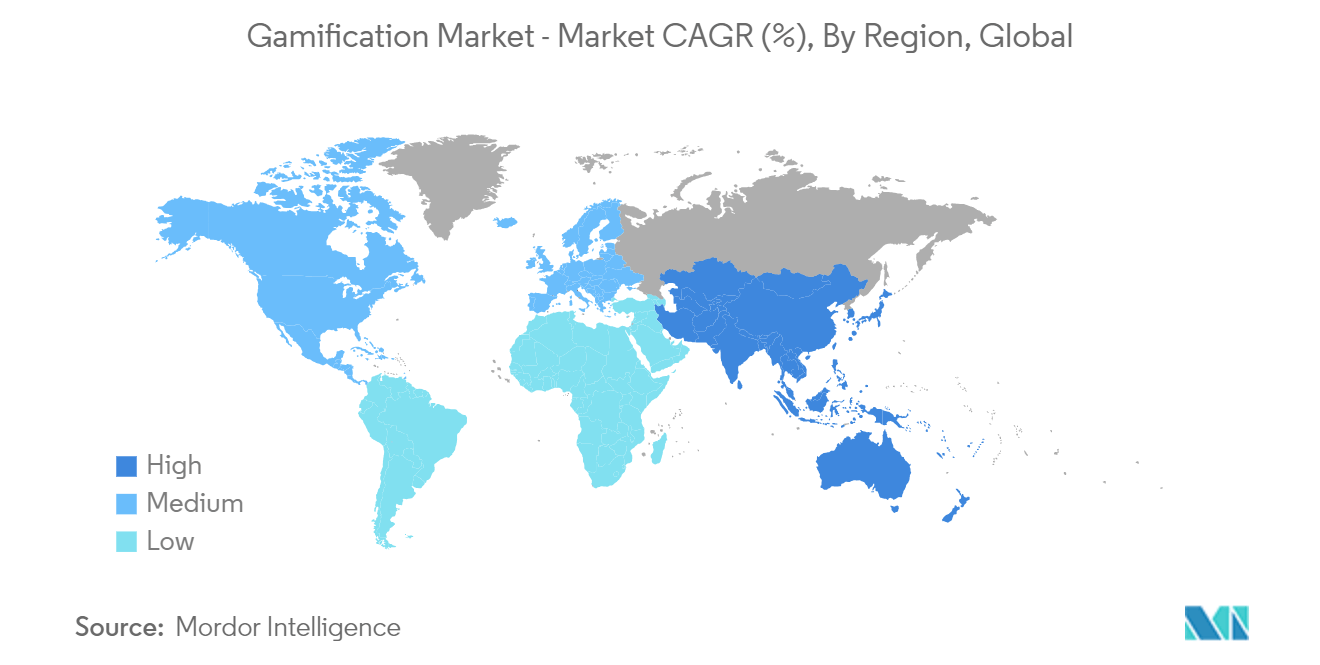Gamification Market Size

| Study Period | 2019 - 2029 |
| Market Size (2024) | USD 15.43 Billion |
| Market Size (2029) | USD 48.72 Billion |
| CAGR (2024 - 2029) | 25.85 % |
| Fastest Growing Market | Asia Pacific |
| Largest Market | North America |
Major Players
*Disclaimer: Major Players sorted in no particular order |
Gamification Market Analysis
The Gamification Market size is estimated at USD 15.43 billion in 2024, and is expected to reach USD 48.72 billion by 2029, growing at a CAGR of 25.85% during the forecast period (2024-2029).
The exponential growth in smartphones and mobile devices directly created a vast base for the gamification market. The increasing recognition of gamification systems also supports this growth as a method to architect human behavior to induce innovation, productivity, or engagement.
- The increasing popularity of smartphones has greatly broadened the possibilities for gamification. The migration of customers and staff from desktop computers to mobile phones and internet devices provides a lucrative platform for banks to grab consumer interest with a higher likelihood of conversion and usage.
- Furthermore, connections with social networking sites have enabled users to share their experiences with friends, acquaintances, and coworkers, extending the platform's reach and efficacy. Another benefit is that mobile applications allow marketers to send out surveys, even if they are only one question long, allowing them to collect firsthand data from their target audience members and tailor their efforts accordingly. Recent MIT research, for example, found that agile organizations experience faster revenue growth and 30% higher profitability than non-agile organizations.
- According to a study on the use of gamification in businesses, it is frequently done in the most generic ways. They employ point systems, leaderboards, and badges in any process rather than designing experiences that balance competition and collaboration. This omission in developing the meaning of this method is expected to result in 80% of the efforts in companies that have used it.
- Furthermore, the adoption of advanced technologies such as AI and ML is expected to gain traction in the coming years, with vendors and enterprises focusing on developing solutions that learn and become more intuitive and effective over time. Vendor investment in the technology is expected to increase in the coming years.
- The gaming industry saw a global spike in mobile game demand since the COVID-19 outbreak, and the statewide shutdown impacted several companies. Smartphone users downloaded various games and other apps during the recent statewide lockdowns imposed nationwide. The Russia-Ukraine conflict also influenced the wider packaging ecosystem.
Gamification Market Trends
The Retail Segment Holds the Largest Share in the Market
- The retail industry is an emerging industry that is growing significantly. Retail sales growth has been increasing steadily over the past few years at a healthy pace as customers seek experiences and products that reflect the personal brand they promote on social media. For instance, according to the data from the US Census Bureau, total retail sales in the United States increased from USD 4.72 trillion in 2015 to USD 6.69 trillion in 2021.
- While gamification can add entertainment and drama to a retailer's marketing or engagement strategy without diverting from the core idea of the business, it can also encourage positive behaviors from customers and employees, leading to a rich brand experience and higher sales.
- As an HBR article points out, gamification also helps in customer retention, increases customer retention rates by 5%, increases profits by 25% to 95%, and can fetch better business results. Brands can provide scannable codes on the products, and on scanning the code, the customer can avail of a certain number of loyalty points. From driving discovery and engagement to building brand advocacy and loyalty, experiential retailers adopt gamification techniques as part of the customer shopping journey.
- Retail gamification is an e-commerce trend that is growing rapidly. Online retailers will want to continue creating interactive customer experiences to drive higher sales. Gamification apps have proven to improve leads and sales for several retailers. Gamification can also drive new and recurring customers to a store.
- By using innovative forms of gamification, retailers find they are better placed to engage with consumers, build brand loyalty, and enhance the overall retail experience. Unsurprisingly, Gen Z is mainly involved with this mechanic. According to Tapjoy, 77% of Gen Zers play mobile games daily. As grocery retailers are keen to build loyalty with this and other segments of the population, it is essential to deploy the right strategy to deliver outstanding results.
- Retailers and brands further benefit from gamification solutions when these include progress charts on what they've achieved through the platform. This could consist of key metrics for users with details on past purchases, friend referrals, and updates on new product categories of interest. A balance of 'wins' or 'rewards' can further engage an audience and drive commercial benefits. This approach can incentivize customers and keep them returning for more when deployed well.

North America is Anticipated to Hold the Largest Market Share
- In marketing, North America has a developed market for gamification. However, systems are finding various regional uses for product development and innovation. The region's high penetration of internet and smartphone users has also resulted in increased use of gamification for marketing, particularly through social media integration tools.
- Various companies have launched large gamification projects since the industry's inception. Consumer brands such as Adobe, NBC, Walgreens, eBay, Panera, and Threadless are among them. Gamification has evolved as a crucial component in B2B firms' consumerization of regional enterprise strategies, such as Oracle, Cisco, and Salesforce.
- Furthermore, these organizations are drawn to gamification's capacity to increase engagement and loyalty by an average of 30% over time, on-site, through repeat visits, and viral diffusion. Aside from engagement, the income effects of gamification are also significant. Autodesk, an American multinational software business, increased trial usage by 40% and conversion rates by 15%, while Extraco Bank increased client acquisitions by 700%.
- Furthermore, global corporations are expanding their presence in the North American market to meet the increasing demand. For example, Low6 Sports Gaming Technology collaborated with gaming consultancy SCCG Management in August 2022. The investment and management organization will assist with the identification and facilitation of North American-based sports betting operators interested in leveraging Low6's technology to gain new customers.

Gamification Industry Overview
The gamification market is moderately competitive and consists of several major players. In terms of market share, a few significant players currently dominate the market. These major players, with a prominent market share, focus on expanding their customer base across foreign countries. These companies leverage strategic collaborative initiatives to increase their market share and profitability.
In September 2022, Bragg Gaming Group's breakthrough player engagement and gamification tool, Fuze, was to be available on sportsbooks, providing operators with a new opportunity to improve the customer experience. The Fuze toolset, already available to customers of Bragg's online casino content via its proprietary distribution platform, was extended to sports betting products, allowing operators to leverage event-driven betting demand with targeted gamified promotions that punters can track in real time.
In June 2022, Microsoft made its Edge browser more gamer-friendly, thanks to Xbox and PC gaming upgrades. Edge is getting a clarity boost to improve Xbox Cloud Gaming streams and an efficiency option to prevent Edge from using PC resources. At the same time, a game is being played, in addition to a new gaming-focused homepage and casual game integration.
Gamification Market Leaders
-
Cognizant Technology Solution Corp.
-
MPS Interactive Systems Limited
-
Microsoft Corporation
-
SAP SE
-
Aon plc
*Disclaimer: Major Players sorted in no particular order
.webp)
Gamification Market News
- August 2022: Low6, the award-winning global leader in sports gamification, partnered with SCCG. The famous gaming industry investment and management firm will assist with identifying and facilitating North American-based Sports Betting Operators interested in leveraging Low6's technology to recruit new consumers.
- March 2022: NSoft, was committed to always providing the finest customer-centric solutions to its partners worldwide. It accelerated the growth of its gamification offer and engagement strategy by adding Ziqni to its operator portfolio. NSoft received a robust and easy-to-use solution through the Ziqni platform as part of the exclusive partnership, allowing it to provide a powerful and highly configurable gamification solution for its iGaming and Casino business partners.
Gamification Market Report - Table of Contents
1. INTRODUCTION
- 1.1 Study Assumptions and Market Definition
- 1.2 Scope of the Study
2. RESEARCH METHODOLOGY
3. EXECUTIVE SUMMARY
4. MARKET INSIGHTS
- 4.1 Market Overview
-
4.2 Industry Attractiveness Porter's Five Forces Analysis
- 4.2.1 Bargaining Power of Buyers/Consumers
- 4.2.2 Bargaining Power of Suppliers
- 4.2.3 Threat of New Entrants
- 4.2.4 Threat of Substitute Products
- 4.2.5 Intensity of Competitive Rivalry
- 4.3 Assessment of COVID-19 Impact on the Market
5. MARKET DYNAMICS
-
5.1 Market Drivers
- 5.1.1 Mobile-based Gamification Gaining Momentum
- 5.1.2 Crowdsourcing Seen as a Major Opportunity in Innovation and Development
-
5.2 Market Restraints
- 5.2.1 Manufacturing Complications and Lower ROI
6. MARKET SEGMENTATION
-
6.1 By Deployment
- 6.1.1 On-premise
- 6.1.2 On-cloud
-
6.2 By Size
- 6.2.1 Small and Medium Enterprises
- 6.2.2 Large Enterprises
-
6.3 By Platform
- 6.3.1 Open Platform
- 6.3.2 Closed/ Enterprise Platform
-
6.4 By End-user Vertical
- 6.4.1 Retail
- 6.4.2 Banking
- 6.4.3 Government
- 6.4.4 Healthcare
- 6.4.5 Education and Research
- 6.4.6 IT and Telecom
- 6.4.7 Other End-user Verticals
-
6.5 By Geography
- 6.5.1 North America
- 6.5.2 Europe
- 6.5.3 Asia-Pacific
- 6.5.4 Latin America
- 6.5.5 Middle East and Africa
7. COMPETITIVE LANDSCAPE
-
7.1 Company Profiles
- 7.1.1 Cognizant Technology Solution Corp.
- 7.1.2 MPS Interactive Systems Limited
- 7.1.3 Microsoft Corporation
- 7.1.4 SAP SE
- 7.1.5 Aon plc
- 7.1.6 Axonify Inc.
- 7.1.7 IActionable Inc
- 7.1.8 Bunchball Inc.
- 7.1.9 Ambition
- 7.1.10 G-Cube
- *List Not Exhaustive
8. INVESTMENT ANALYSIS
9. MARKET OPPORTUNITIES AND FUTURE TRENDS
** Subject To AvailablityGamification Industry Segmentation
Gamification uses the human tendency to influence one's thinking process by engaging users to become effective problem solvers, even in the real world. Gamification has proven its benefits in different activities, such as customer experience enrichment, employee engagement, and providing rewards to people.
The market studies the deployment type, such as on-cloud and on-premise, along with the organization's size, platform, end-user vertical, and geographical analysis throughout the forecast period. For the study, various factors such as consumer spending, consumer preference trends, the impact of COVID-19, and other macroeconomic factors are considered to arrive at the overall market projections.
The gamification market is segmented by deployment (on-premise, on-cloud), size (small and medium enterprises, large enterprises, platform (open platform, closed/ enterprise platform), end-user vertical (retail, banking, government, healthcare, education and research, IT and telecom), geography (North America, Europe, Asia-Pacific, Latin America, Middle East and Africa). The market sizes and forecasts are provided in terms of value (USD) for all the above segments.
| By Deployment | On-premise |
| On-cloud | |
| By Size | Small and Medium Enterprises |
| Large Enterprises | |
| By Platform | Open Platform |
| Closed/ Enterprise Platform | |
| By End-user Vertical | Retail |
| Banking | |
| Government | |
| Healthcare | |
| Education and Research | |
| IT and Telecom | |
| Other End-user Verticals | |
| By Geography | North America |
| Europe | |
| Asia-Pacific | |
| Latin America | |
| Middle East and Africa |
Gamification Market Research FAQs
How big is the Gamification Market?
The Gamification Market size is expected to reach USD 15.43 billion in 2024 and grow at a CAGR of 25.85% to reach USD 48.72 billion by 2029.
What is the current Gamification Market size?
In 2024, the Gamification Market size is expected to reach USD 15.43 billion.
Who are the key players in Gamification Market?
Cognizant Technology Solution Corp., MPS Interactive Systems Limited, Microsoft Corporation, SAP SE and Aon plc are the major companies operating in the Gamification Market.
Which is the fastest growing region in Gamification Market?
Asia Pacific is estimated to grow at the highest CAGR over the forecast period (2024-2029).
Which region has the biggest share in Gamification Market?
In 2024, the North America accounts for the largest market share in Gamification Market.
What years does this Gamification Market cover, and what was the market size in 2023?
In 2023, the Gamification Market size was estimated at USD 12.26 billion. The report covers the Gamification Market historical market size for years: 2019, 2020, 2021, 2022 and 2023. The report also forecasts the Gamification Market size for years: 2024, 2025, 2026, 2027, 2028 and 2029.
How is Gamification being used in education?
In education, gamification is used to make learning more engaging and interactive, with elements like points, badges, and leaderboards to motivate students and track progress.
What are the latest trends in the Gamification Industry?
The Latest trends in the Gamification Industry include: a) Integration of Artificial Intelligence and machine learning for personalized experiences b) Use of Augmented Reality (AR)/ Virtual Reality (VR) for immersive experiences c) Focus on social gamification for community building
Gamification Industry Report
The Gamification Market is booming, fueled by the demand for engaging solutions in sectors like telecom and retail, aiming to enhance customer satisfaction and loyalty. This growth is powered by the adoption of gamification strategies, which are proving effective in boosting employee engagement and customer interaction through rewards and recognition. North America leads in adopting these solutions, with the integration of artificial intelligence (AI) technology paving the way for more personalized strategies. The services segment, offering consulting and implementation, is witnessing rapid growth, essential for tailoring gamification to specific business needs. As businesses recognize gamification's potential to drive engagement, productivity, and innovation, the future looks promising. This trend is supported by gamification statistics and trends, indicating a significant market expansion. For detailed insights, Mordor Intelligence™ provides a comprehensive analysis, including market share, size, and revenue growth rate, available as a free report PDF download.



